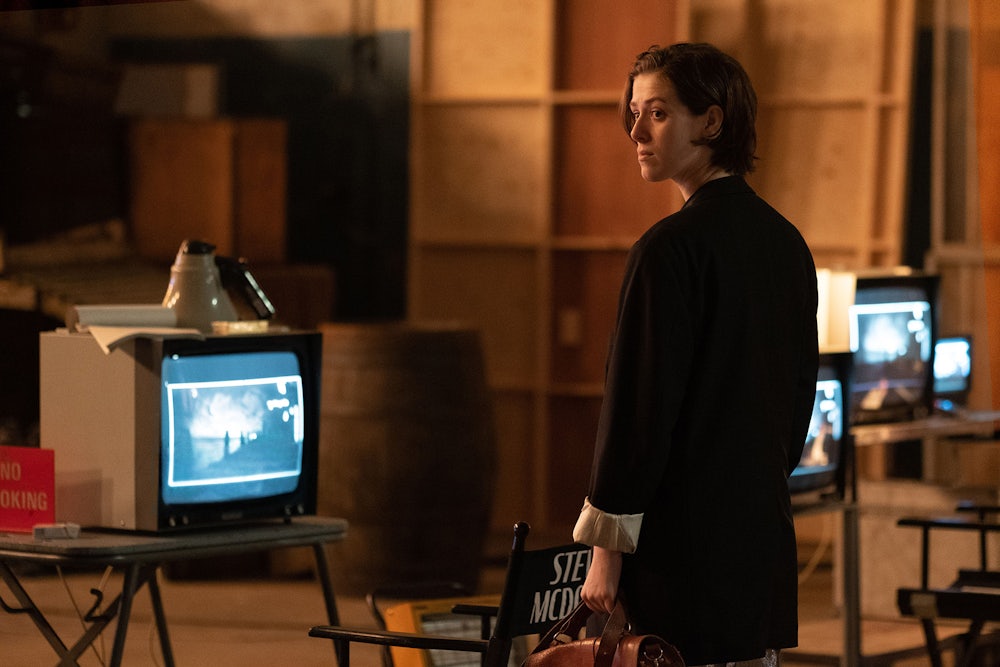At one point in Joanna Hogg’s 2019 film, The Souvenir, Tom Burke’s character, Anthony, asks the protagonist, Julie, played by Honor Swinton Byrne, “Am I more real than you?” Since they both know the correct answer, she says no—no one is more real than anyone else—and yet, as she says it, you sense her lack of conviction. One of the marvels of Swinton Byrne’s largely improvised performance as a film student in 1980s London is how thoroughly she inhabits a self that’s still unformed, even the soft flesh of her face making her appear almost to smudge at the edges.
But Anthony’s question isn’t explicitly about Julie’s pliancy, a quality that will soon allow him to manipulate and sponge off her. He’s talking about cinema, and whether Julie, the hopelessly earnest novice auteur, is already doing it wrong. She has thrown herself into making a film about a working-class boy called Tony, whose life, in a Sunderland declining swiftly along with its shipyards, she seems to perceive as grittier and thus more real than her own. Anthony, with his imperious drawl and immaculate pinstripe suit, can’t contain his smirk. He explains to Julie with exaggerated patience that, when watching a film, “We don’t want to just see life played out as is; we want to see life as it is experienced within this soft machine.” On the merits, he’s right, and what’s more, his suspicion of authenticity seems hard-won: Unlike Julie, who comes from a type of English money, comfort, and breeding that she’s eager to imagine her way out of, Anthony, faking a job at the foreign office and concealing his dependence on heroin, is an expert in self-fashioning.
The Souvenir follows the familiar arc of their relationship: early infatuation, during which he moves in with her and encourages her to dress and think differently; the gradual erosion of trust as he disappears repeatedly and drains her money; and eventually the trauma of his sudden death. When The Souvenir: Part II begins, Julie has taken refuge at her parents’ country house to grieve for him and disentangle the effects of his various deceptions. We then observe her efforts to make a film that will express what happened to her.
Anthony and Julie had been engaged in a struggle over interpretation: When they look at the Fragonard painting that gives the films their title, of a young woman carving her lover’s name into a tree, Julie sees her as sad, while Anthony insists she is determined. By dying, he has ceded the field, and Julie can impose whatever meaning she chooses, so long as she can muster the ingenuity and determination to subdue her equipment, her cast, her material. This sequel transfigures the pains of the first Souvenir into something buoyant, seductive, funny, surprisingly frothy at times. Yet while the most lovable movies about moviemaking—from Sullivan’s Travels to Day for Night to Irma Vep—tend to be comic romps, Hogg risks treating the creative development of a privileged young woman with disarming seriousness.
It took Joanna Hogg many years to allow herself that treatment. Born in 1960, she attended West Heath—the same boarding school that Princess Diana attended—then the National Film and Television School, where she made a short film, Caprice, starring her schoolmate Tilda Swinton (Swinton Byrne’s mother, who also plays Julie’s mother in both Souvenir films). But for a long time, her directorial talents were confined to British soap operas like Casualty and London’s Burning. She was well into her forties before she began making features. Her first three films, Unrelated, Archipelago, and Exhibition, are deft studies of contemporary upper-middle-class British people dealing with their problems while trapped in proximity—a Tuscan villa, a vacation home in the Scilly Isles, a stifling dinner party. Hogg likes to mirror the conditions on-screen by having her cast live close together during shoots, filming in chronological order and often from outlines rather than finished scripts; she favors long takes in which subtle dynamics have room to play out.
The Souvenir traced the shaky emergence of a talent like Hogg’s own from the awkwardness of early adulthood. The patronizing filmmaking advice Julie receives from the more confident people around her is often painfully apt. There’s the older film-student character played by Richard Ayoade, who speaks with a flourish to match his abundant curls and leopard-print coat, telling her to shoot according to “the Tolstoy definition of art…. You just have a feeling and by means of external signs you communicate it to someone else.” Film school, he declares, is merely “the cheapest camera-hire place in the world.” He has little use for the faculty, since “telling someone how to make a film is like telling you how to breathe or how to think.... There are no rules.” Her anxious, receptive expression as she listens to him confirms that she’s not yet capable of acting the way he recommends.
The faculty, meanwhile, are skeptical of her Sunderland idea (which is based on a project Hogg herself abandoned in film school). They suggest she choose a subject closer to her own experience, yet when Julie turns to personal material in Part II, they seem aghast, suddenly looking back with nostalgic approval on the serious social dimension of her first idea. The Souvenir films together form a Künstlerroman in which Julie learns to ignore other people’s advice and to exercise authority—even as some of her collaborators grow comically incensed at her intuitive, improvisatory style of filmmaking, which involves scrapping previously agreed schedules and outlines at the last minute.
Julie has a cast reenact scenes we remember from the first film, and thus finds the detachment she needs to make sense of herself: The nonactor she chooses to play a version of her can’t understand, for instance, how Julie could not confront the Anthony figure over the signs that he’s lying—the process of making the film becomes an exploration of how to lend narrative or aesthetic coherence to the chaos of human feeling and behavior. The Richard Ayoade character reappears as a kind of double and foil to Julie, frustrated by the limitations of everyone around him as he struggles to make the lavish musical he envisioned in The Souvenir. Whereas Julie annoys her crew by groping her way toward her vision, he is so overbearing in his that he’s eventually thrown out of the editing room.
The Souvenir is the first of Hogg’s films to travel back in time, and it does so by channeling the intensity of remembered objects and conversations. The film’s settings and trimmings are lush and opulent—the busy, gilded furnishings and wallpaper of the Wallace Collection where Julie and Anthony spend afternoons; the grand Venice hotel they stay in; even the Knightsbridge flat where they live courtesy of her parents. The transformation that Anthony encourages in Julie’s wardrobe adds to the effect: At one point, we see the gleaming, twitching hem of her dress ascending a staircase, like that of a Henry James heroine in distress. Whereas a period piece would usually get such details right in order to render them invisible and transport the audience, Hogg draws our attention all the time to the effortful reconstruction of her memories (and their proximity to fantasy). In that way, watching The Souvenir feels rather like looking at footage or photographs of your own youth: The pieces you’d forgotten collide with those you still fixate on; it’s all charged, as mysterious as it is familiar; you have no idea why you did that and wish fervently that you could go back and change it, while also knowing that you can, and have—that those things, events, and people are shifting each time you summon them to mind.
There are moments in The Souvenir: Part II that in another context could seem heavy-handed. Not long after Julie’s mother shows off a small pot she has made in her ceramics course, Julie accidentally drops and breaks it. The daughter unthinkingly puts her mother’s efforts in their place—a housewife’s hobby. There’s only room for one artist; or perhaps it’s that one woman must sacrifice so that another can find the selfish disregard that art seems to require. Either way, a basic legitimacy is at stake: Even if you can afford the time and money to make pretty things, they will not count as art unless you make them count. Since the film’s central subject is the impulse to create and the difficult, halting process of doing so, such symbolism feels like an organic part of how Julie is filtering her experience. The ceramic breaking (which in old novels would stand in for lost innocence) is the kind of small but theatrical event that in real life can bring into focus all the unconscious stories you’ve been carrying about your own behavior. The intense flash of pain and shame—abrupt awareness of yourself and of how you treat others—is what lodges the incident in the mind.
Whereas The Souvenir framed its concerns with memory and art within the structure of a conventional realist drama—driven by the travails of love, secrets, lies, betrayal, class, family, addiction, mortality—Part II dispenses with any plotting or suspense outside of whether and how the protagonist will make her film, whether it will succeed in transfiguring what needs to be transfigured. Having first established the analogy between an artist’s working through events, memories, fantasies, and feelings and the universal human experience of doing so, Hogg here takes art as the only source of drama. She examines the struggle to make art that justifies itself solely through its own form and power, that creates its own reality, so that questions of mere subject matter—Anthony or Tony!—become irrelevant. As the film progresses, Hogg experiments further, violating some of the terms of the reality she has established and daring the audience to go along, to accept her exuberant visual and emotional logic over what the film’s manifest characters and setup seemed to offer.
It’s a trick that could only work in cinema, where processes feel more magical the more closely we’re allowed to look at them. A novel about a writer might sometimes feel like a cop-out, because the novel’s spell is to drop you into other people’s interiors—preferably not only that of someone sweating at her desk. The words, on having their effect, are meant to disappear, whereas a sequence of images transmits a feeling by absorbing its intensity, threatening to stay with you long after you’ve been parted from the screen.






